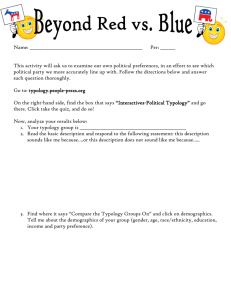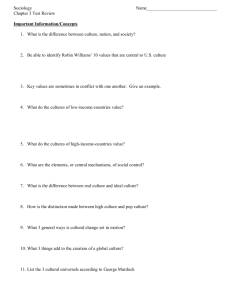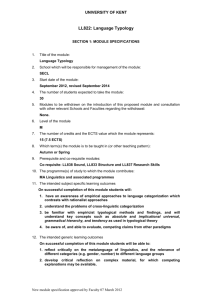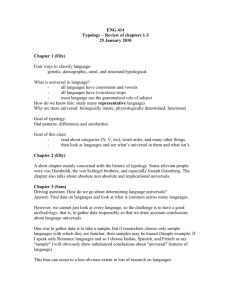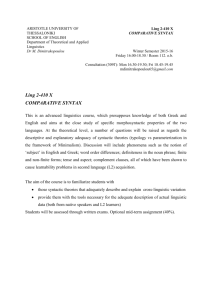Introduction to Linguistics 2
advertisement
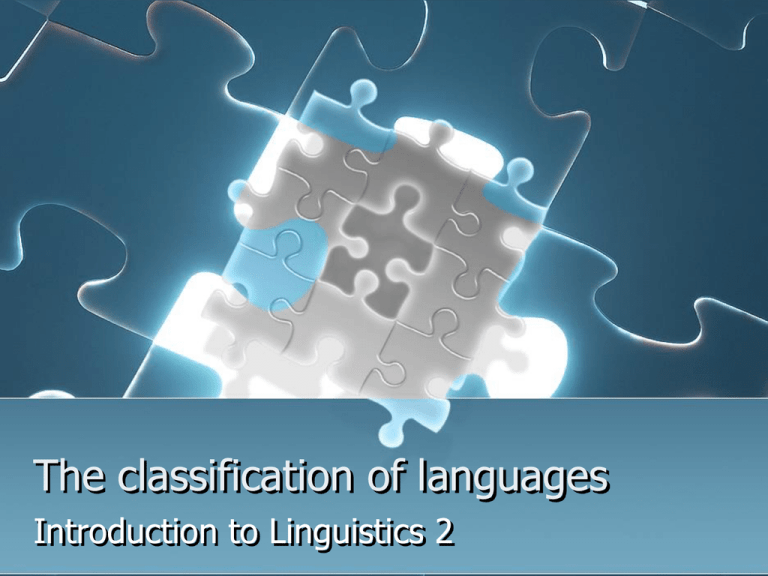
The classification of languages Introduction to Linguistics 2 Defining language Dialect and language Defining criteria If two speeches are mutually intelligible, they are dialects. Fuzzy boundaries Claimed to be one language, but there are a variety of mutually unintelligible ‘dialects’. Chinese Taiwanese, Wu… Cantonese, Mandarin/ Putonhua, Claimed to be two independent languages, but they are actually mutually intelligible. Serbian and Croatian Approaches to language classification Genetic classification Linguistic typology Genetic Classification Genetic classification Languages with related historical decent are said to be genetically related. ‘language families’ Language families Case Study: The Indo-European language family Linguistic Typology Linguistic typology Languages are grouped together according to the similarities of their linguistic features. Linguistic Universals The common linguistic features that are found in all or most languages. How to describe linguistic universals Absolute universals vs. universal tendencies Implicational universals Markedness theory Absolute universals vs. universal tendencies Absolute universals The linguistic features that occur in ALL languages Universal tendencies The linguistic features that occur in MOST languages Implicational universals The presence of one linguistic feature in one language must indicate the occurrence of another. If A is found in language L, B must be also present in language L. The implication is one-way. Example: If one language has fricative phonemes, it will also have stop phonemes Implicational universals: Example The implication is one-way. Example: If one language has fricative phonemes (/s/, /z/), it will also have stop phonemes (/p/, /t/). But not vice versa. Markedness theory The most common/default features are unmarked. The less common features are marked. Markedness theory: example Gender in nouns Which is marked? Masculine or feminine? Prince-princess; actor-actress Doctor-female doctor; nurse-male nurse 萬綠叢中一點紅 Which is marked? Typological classification by Phonology Morphology Syntax Typology: phonology Vowel systems Consonant systems Suprasegmental systems Syllable structure Typology: phonology: vowel Universals The most common vowel system 5 vowels /a/-/i/-/u/-/e/-/o/ The most common phonemes /a/-/i/-/u/ Front vowel phonemes are generally unrounded. Low vowels are generally unrounded. Typology: phonology: Consonant Universals All languages have stops /p, t, k/ The most common fricative phoneme is /s/ Most of languages have at least one nasal. Implicational universals Fricatives -> stops Voiced obstruents -> voiceless obstruents Affricates -> stops and fricatives Typology: phonology: suprasemental Types Tone languages Languages that use pitch to make semantic distinctions of words Mandarin Chinese Stress languages Fixed stress Free stress Syllable structure CV, V Typology: morphology The isolating type The polysynthetic type The synthetic type The agglutinating type The fusional type Typology: morphology: The isolating/analytic type One word represents one single morpheme. No affixes Mandarin Chinese Typology: morphology: The polysynthetic type One single word with a long string of roots and affixes The semantic equivalent of one sentence in other languages. Qasu-iir-sar-vig-ssar-si-ngit-luunar-nar-puq ‘some one did not find a completely suitable resting place.’ (Inuktitut) Typology: morphology: The agglutinating type An agglutinating words Contains several morphemes The root and affixes in the words can be semantically identified. Swahili Tu –ta –wa -on- esha we-fut.-them-see-cause 'we will show them' An aggluinating example: Antidisestablishmentarianism establish (9) dis-establish (12) ending the established status of a body, in particular a church, given such status by law, such as the Church of England disestablish-ment (16) to set up, put in place, or institute (originally from the Latin stare, to stand) the separation of church and state (specifically in this context it is the political movement of the 1860s in Britain) anti-disestablishment (20) opposition to disestablishment an advocate of opposition to disestablishment the movement or ideology that opposes disestablishment antidisestablishment-arian (25) Antidisestablishmentarian-ism (28) Typology: morphology: The fusional/inflectional type A fusional/inflectional word contains several morphemes which indicate grammatical categories. Ein kleiner Hamster "a little hamster" (nominative case) Der kleine Hamster "the little hamster" (nominative case) Ich sah den kleinen Hamster "I saw the little hamster" (accusative case) Mit kleinem Hamster "with little hamster" (dative case). Typology: syntax Word order universals SVO SOV VSO Word order: SVO John loves Mary. word order: SOV 私 は 箱 を 開けます。 watashi-wa-hako-o-akemasu. I box open ‘I open the box.’ word order: OSV Sentence Words Parts Translation قرأ المدرس الكتاب الكتاب المدرس قرأ al-kitāba al-mudarrisu Qara'a Read. the teacher the book Object Subject Verb The teacher read the book.
